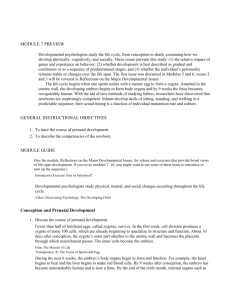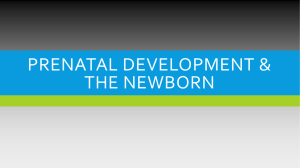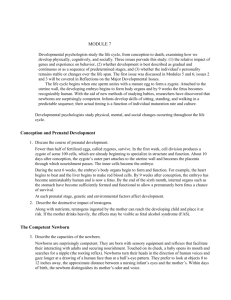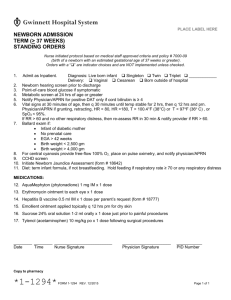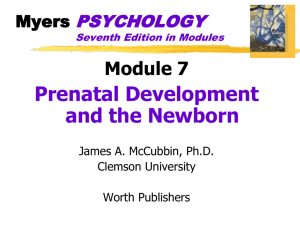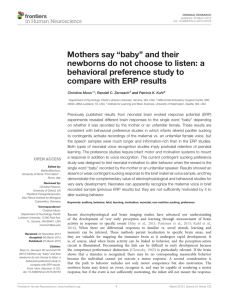5/22: Prenatal & newborn development
advertisement
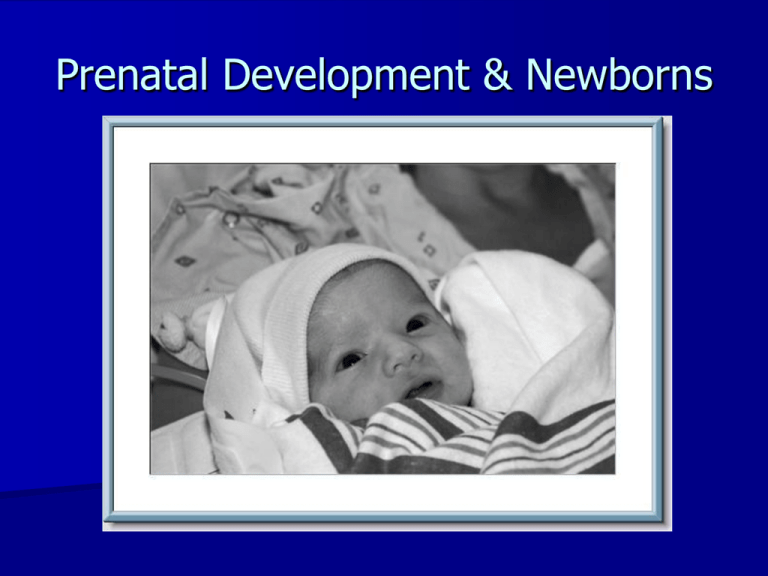
Prenatal Development & Newborns 1. How soon after conception does brain begin to form? 2. What are the 4 parts of the brain and the function of each? 3. What does nerogenesis mean? 4. What are the parts of a neuron and how do they communicate? In-class Assignment 2 The purpose of this assignment is to help you better understand the three phases of prenatal development. Teratogens Agents that causes damage during prenatal development; effect depends on… – Dose level & length of exposure – Genetic variability of mother & organism – Multiple influences versus a single agent – Age or whether organism is in a sensitive period Figure 3.2: Sensitive periods in prenatal development Teratogens Agents that causes damage during prenatal development; effect depends on… – Dose level & length of exposure – Genetic variability of mother & organism – Multiple influences versus a single agent – Age or whether organism is in a sensitive period Effects may be delayed & psychological Includes **drugs, diseases, & environment** 1. Alcohol Statistics – – 25% of expectant mothers report drinking 55% for those who might become pregnant Dose: < 1 glass/day is harmful Sensitive period: Earliest months of pregnancy Effects: Fetal Alcohol Syndrome (FAS) – Physical (facial) abnormalities Fetal Alcohol Syndrome: typical facial abnormalities 1. Alcohol Statistics – – 25% of expectant mothers report drinking 55% for those who might become pregnant Dose: < 1 glass/day is harmful Sensitive period: Earliest months of pregnancy Effects: Fetal Alcohol Syndrome (FAS) – – Physical (facial) abnormalities Long-term mental retardation & overactivity 2. Tobacco Statistics – 12% report smoking during pregnancy Dose: more is worse; even 2nd-hand is bad Sensitive period: throughout, but reversible Effects: – – – Low birth weight Behavioral disorders (ADD & ADHD?) Long-term cognitive delays Long-term cognitive effects of smoking 2. Tobacco Statistics – 12% report smoking during pregnancy Dose: more is worse; even 2nd-hand is bad Sensitive period: throughout, but reversible Effects: – – – Low birth weight (low nutrients) Behavioral disorders (ADD & ADHD?) due to CO2 Long-term cognitive delays 3. Cocaine Statistics – 1980s phenomenon; estimate 11% Dose: unknown because of multiple influences Sensitive period: throughout Effects: – – – – Born addicted & experience withdrawal Shrill & piercing cry Low birth weight Long-term consequences? Less so if environment changes What are newborns capable of? Newborn Capabilities: Reflexes Inborn, automatic response to stimulation Why? Serves a function – Survival of newborn (e.g., sucking) – Motor development (e.g., stepping) – Evolutionary, no longer important (e.g., Moro) – Parent-newborn bonding Reflexes Reflexes Newborn Capabilities: Reflexes Inborn, automatic response to stimulation Why? Serves a function – Survival of newborn (e.g., sucking) – Motor development (e.g., stepping) – Evolutionary, no longer important (e.g., Moro) – Parent-newborn bonding Most disappear at 6-months; voluntary control of behavior Newborn Capabilities: Senses Sense Capability Touch Sensitive to touch, pain, & temperature Taste Distinguish between tastes, likes & dislikes Smell Can distinguish mother from other women Hearing Speech perception is better than adults Prefer high-pitched, expressive sounds Sight Least mature, lack visual acuity, yet look for stimulation Dr. Suess Studies Decasper & Fifer (1980) Dr. Deuss Studies Decasper & Fifer (1980) Participants: 10 newborns (24 hours old) Method – Earphones on infants played tape-recording of mother (and stranger) reading Dr. Suess story – Pacifier in babies mouth monitored sucking Results: newborns suck more in response to mother’s voice 0.45 0.4 0.35 0.3 0.25 0.2 0.15 0.1 0.05 0 mother stranger Baseline Mother Baseline


